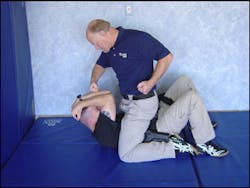From the Bottom to the Top
As a police officer, you should possess at least a cursory knowledge of the fighting arts in order to familiarize yourself with techniques that could be used against you. While I'm not suggesting you obtain a black belt in Brazilian Jiu-jitsu in preparation for a second career as a "cage fighter" upon retirement, I think watching a mixed martial arts (MMA) competition on television would be a worthwhile endeavor.
I'm the first to point out that certain MMA tactics seem ill-suited for use by police officers. For example, intentionally going to the ground with a suspect, even if you achieve a dominant position, is usually not a good idea. Being on the ground leaves you vulnerable if there is more than one suspect and presents a myriad of weapon retention problems. Of course, the suspect might dictate that the fight goes to the ground. If you end up on your back, with the suspect on top of you, you better have a plan. Escaping the mount is a strategy that should be in every officer's repertoire.
What is the mount?
The mount is one of the most dominant positions in MMA. It involves one fighter sitting on the other fighter's abdomen or chest, with the top fighter's legs positioned to the outside of the downed fighter's legs.
The mount is dangerous for the fighter on the bottom for several reasons. One of the most obvious is that the top fighter has a tremendous leverage advantage. From this superior position, he can rein down devastating punches, as well as elbow and hammer fist strikes. Conversely, the fighter on the bottom has significantly less ability to generate powerful strikes, since being sandwiched between his opponent and the ground limits his range of motion.
As if that weren't motivation enough to keep from being mounted, there are numerous joint locks and chokes that can be employed by the top fighter. In the cage, these often lead to the bottom fighter "tapping out." On the street, a joint lock could translate to a joint break. (Having your elbow bend both ways could make for a difficult fight). Worse yet, on the street, a choke could result in you "passing out" rather than "tapping out." If you are rendered unconscious, you will be left at the mercy of the scumbag who attacked you. If he decides to take your firearm you might never wake up from your nightmare.
How do I escape from the mount?
If you are knocked to the ground and the suspect achieves the mount, you are not going to die! Just realize that you are in a precarious situation and will need to fight like hell to get the suspect off of you.
Step 1 (Head up)
Keep your chin tucked and your head off the ground. This ensures your head can move with the blow if struck, minimizing damage. If your head is on the ground when struck, you will absorb the full impact of the blow, since your head is essentially braced against the ground.
Step 2 (Cover)
Probably the best way to protect your head from strikes is to grab the back of your head with both hands, while squeezing your elbows together in front of your face. This offers considerably more protection than placing your hands in front of your face and has much better odds than trying to block each incoming strike.
Step 3 (Buck)
Minimizing damage is one thing but now it's time to get the offender off of you!
With your knees bent and your legs drawn in as far as possible, plant your feet firmly on the ground. Push off with your feet and forcefully thrust your hips up as high as you can. If the suspect remains balanced on top of you, use one of your knees to strike him after bucking your hips. (You can also grab the suspect's torso to help propel his weight over your head). The suspect will have to place both hands on the ground to keep from doing a "face plant".
With both of the suspect's hands on the ground, you have effectively re-distributed his weight off your body. Now it's time to transition from the bottom to the top!
Step 4 (Arm shear)
In a shearing action, collapse one of the suspect's arms by striking the inside portion of the elbow, while using your other hand to push against the triceps of the suspect's opposite arm. Thrust your hips up as before and drive the suspect in the direction of his collapsed arm, sweeping him onto his back. At this point, you should be able to stand and draw an appropriate gadget from your bat belt.
A "cop-friendly" technique
This technique works well for police officers for a couple of reasons. First, it takes into account that the suspect will be positioned higher on your torso due to the placement of your duty belt. This leaves him more susceptible to being bucked forward. Secondly, forcing the suspect to momentarily place his hands on the ground prevents him from striking you or in the case of an armed suspect, using a weapon against you.
Conclusion
As you might have guessed, being on the wrong side of the mount is not a good place to be. Your best bet is to develop a good sprawling technique to avoid being taken down and mounted. If you are mounted, at least you now have an effective strategy for escaping.
If you haven't tried wrestling on the ground wearing your duty belt and ballistic vest, you need to! Get a feel for what works while wearing gear and what doesn't. If you've trained from your back in full gear, you're less likely to panic if a suspect mounts you on the street.
Train hard and stay safe!
Web Links:

